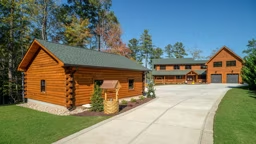
Cute as they are, raccoons can be a real nuisance to home owners. They’re clever, dexterous and will eat pretty much anything that is edible. Here are five tips for how to get rid of raccoons from your log home's property.
Secure Your Garbage
The number one problem with raccoons is their attraction to a home’s garbage cans. Unfortunately, the typical garbage can lid is no match for raccoons. Raccoons can open lids easily with their paws; if that doesn’t work, they’ll dislodge the lid by knocking the entire can over. Before you know it, you’re waking up to a driveway full of rotting—and smelly—kitchen garbage.
In order to prevent this, try using bungee cords or heavy cinder blocks to secure the lids. Many companies produce inexpensive bungee systems that will securely hold your lid in place.
Better yet, invest in raccoon-proof garbage cans, such as the Bear Strength model from Bearicuda.
Remove Any and All Food Sources
Make sure there is nothing edible whatsoever around the perimeter of your home. Check for:
-
Pet food and water
-
Overripe vegetables in your garden
-
Fallen fruit from trees
-
Bird feeders
Clean Up Your Landscaping
Don’t give raccoons an environment that allows them cover on their nocturnal food searches. Trim large bushes, remove brush, and keep your lawn mowed. Raccoons don’t like to be exposed in open space, so consider installing bright, motion-sensitive lighting around areas that might attract them.
Seal Up Any Entrances to Your Home, Garage or Shed
A family of raccoons will sometimes take up residence in your home—for example, under your porch or in a remote corner of your shed. Be sure and check around the perimeter of your home’s garage, shed, basement, outbuildings, alleyways or crawl spaces. Additionally, check around your home’s attic, chimney, or any low-hanging eaves. Any small spaces that provide even 4 or 5 inches of access should be sealed.
Note: If you do find a family of raccoons living in or around your home’s property, they are most likely raising a litter of youngsters. You’ll have to wait several weeks for the babies to mature before starting eviction proceedings. If the brood leaves on its own accord, you can then seal up the hole to prevent them—or others—from coming back.
Last Resort: Trap & Remove
Many states do not allow homeowners to trap and remove animals themselves, so if your raccoon problem gets truly out of hand, your best bet is to call a professional or your local animal control. This not only ensures that the raccoons will be removed in a legal and safe way, but also humanely.
Professional wildlife removal specialists will employ a variety of methods to rid your home of these pesky guests, including live trapping and exclusion. Exclusion involves covering the openings the raccoons use to enter with special doors, netting or tubes. The raccoons can leave, but are unable to crawl back in again.
Read More About Pest Control From Log Home Living:











